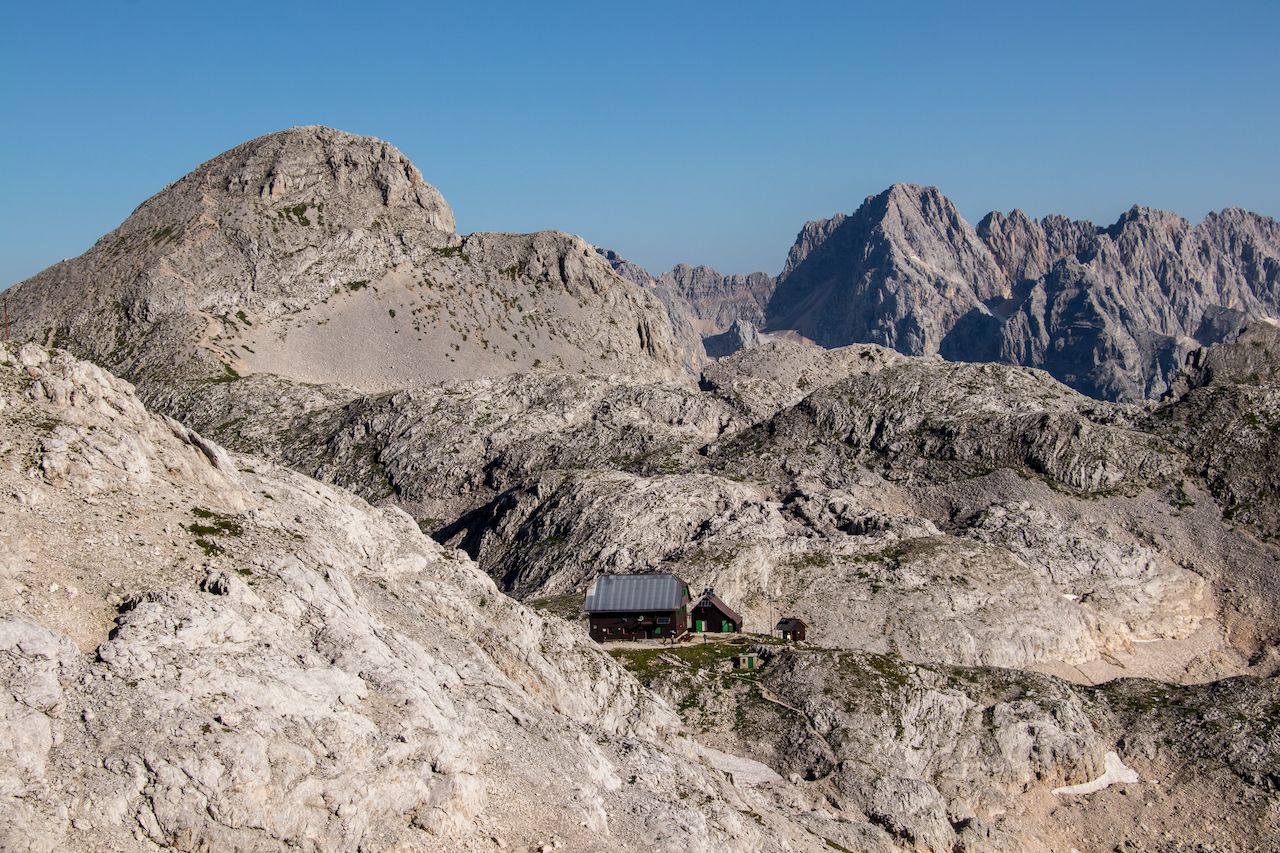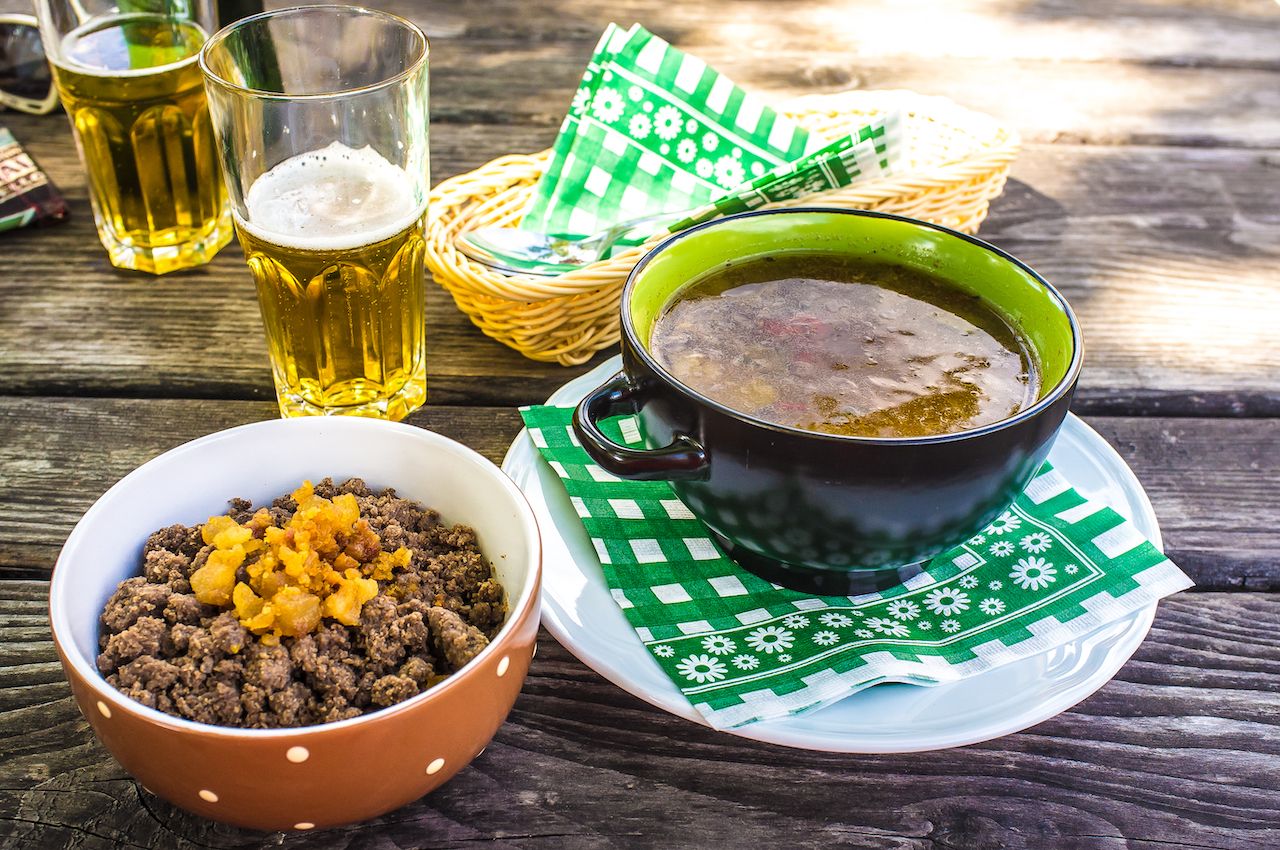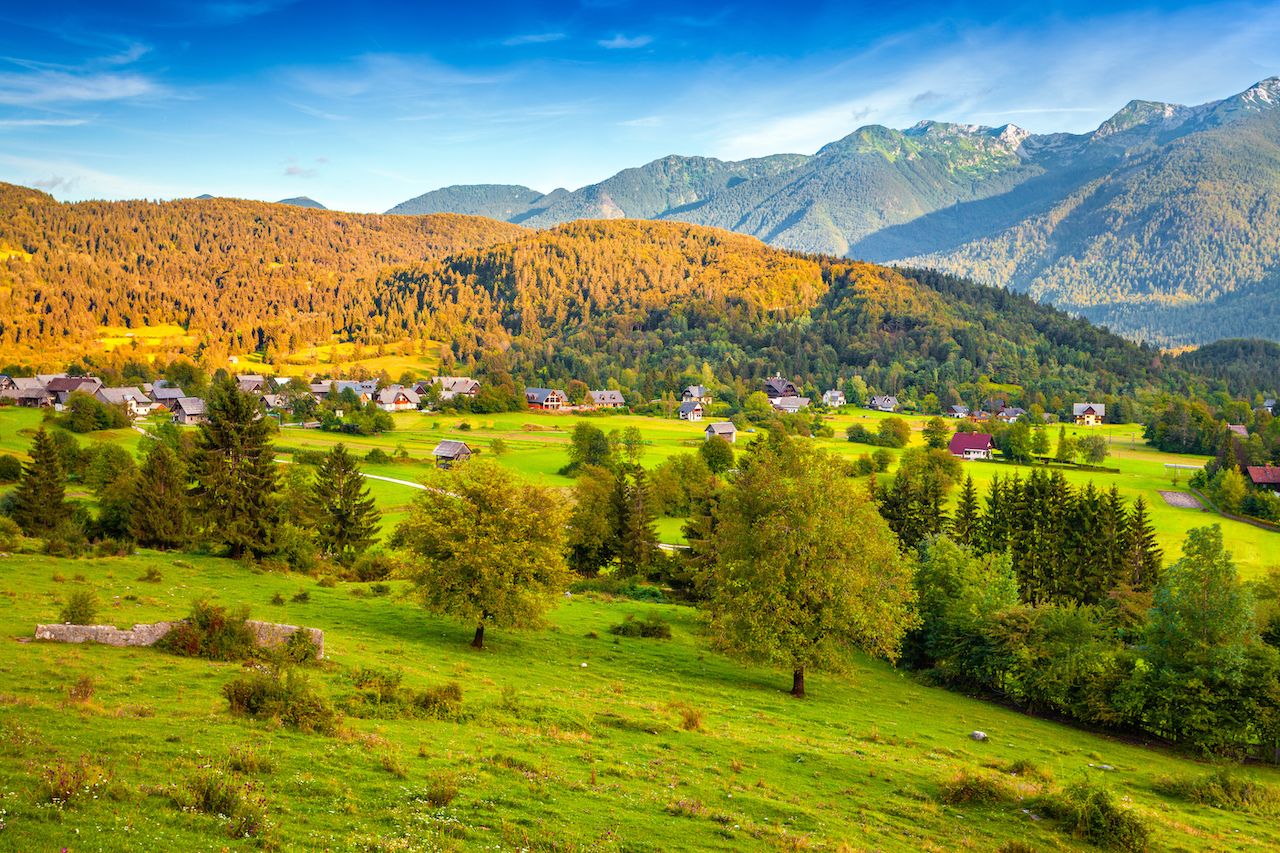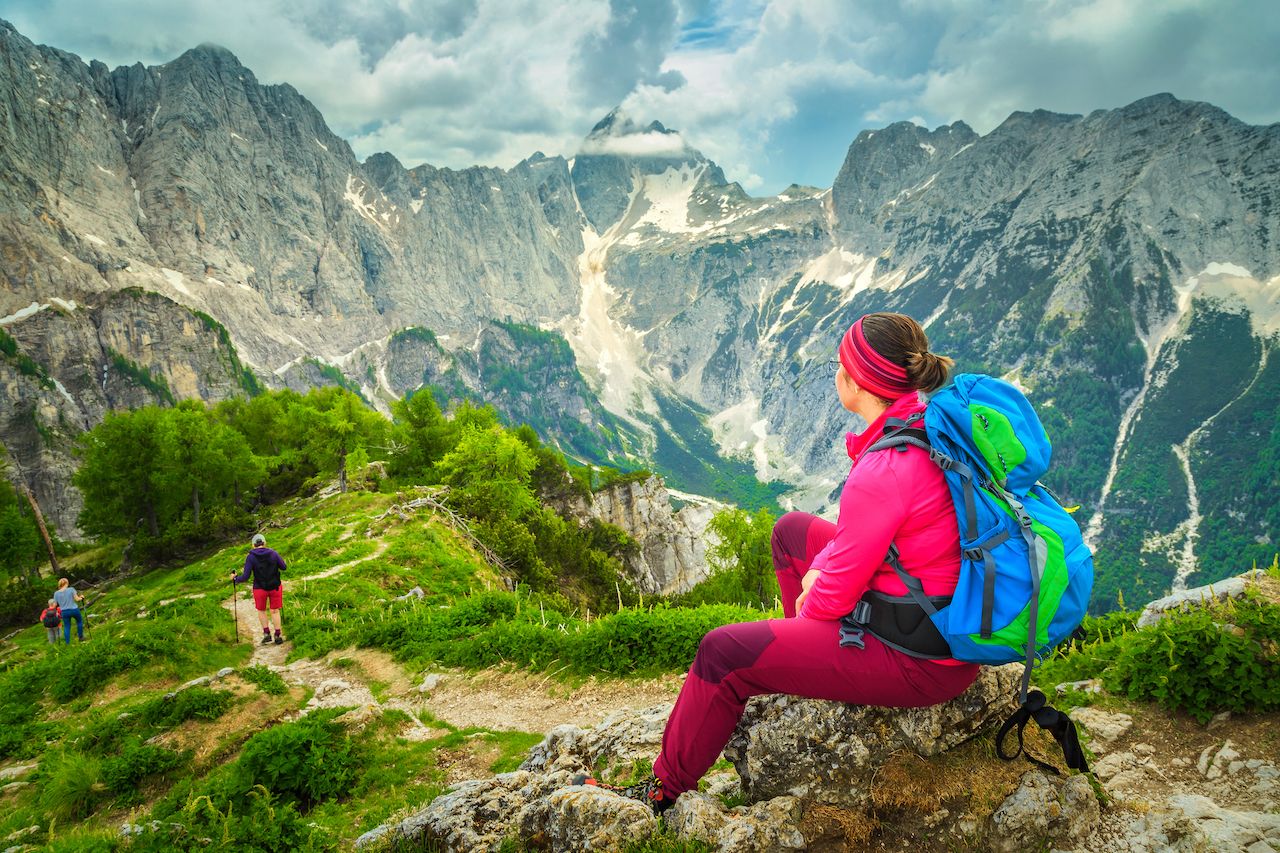Dramatic views and challenging trails by day, savory goulash and a warm bed by night — Slovenia’s backcountry hut system brings the creature comforts of civilization into the wild, no tent required (and technically not allowed, per Slovenian law). Dotting the entire country and connected by a series of trail systems across Slovenia’s stunning Julian Alps, access is on your own two feet. And while they offer real beds and homemade comfort food, Slovenia’s huts are also budget-friendly. Here’s what you need to know.

How to Go Hut-to-Hut Hiking in Slovenia’s Glorious Julian Alps
Why hut-to-hut hike in Slovenia?

Photo: Raphael Rivest/Shutterstock
Hiking is a national pastime for Slovenians, which has led to an extensive and well-kept trail system. Wild camping, or pitching your tent on the side of the trail, is officially prohibited, meaning that if you want to overnight in the backcountry, you have to stay in a hut. Consider hut-to-hut hiking a chance to treat yourself. Slovenia is essentially twisting your arm to stay in gorgeous alpine chalets, complete with flowery window boxes. Well, if you insist!
The trails to reach the huts wind through dense forest, bare mountaintops, and lowland pastures, meaning that hiking is an option for a variety of fitness levels. Dotted with shepherds’ huts selling homemade cheese, traditional wooden troughs with spigots (meant for livestock but useful for empty water bottles), and rustic trail signs, everything man-made blends into its surroundings.
My husband and I chose to hike in Triglav National Park, the country’s largest protected area and only national park. The park is named for the highest peak in the country, the 9,39-foot-high Mount Triglav. Mount Triglav is a source of national pride, and it’s said that every “true” Slovenian should climb to its summit at least once in their lifetime. Our hiking plans would not include Mount Triglav on this trip, but they did comprise stays at three of the country’s 100-plus huts.
From the capital Ljubljana, the nation’s hometown-like capital, the Julian Alps are about a two-hour drive due north. Our hiking route departed right from the streets of Stara Fužina at the southern end of Triglav National Park, from were we headed uphill into the mountains.
The Planinska koča na Vojah hut was easy to reach from town, feeling more like a stroll than a hike. We extended the walk by trekking on to “Slap Mostnice,” a name we found hilarious but which translates to “Mostnice Waterfall.” The following day, the Koča na Planini pri Jezeru hut took more effort to reach — switchbacks not being a popular trail feature in Triglav — but I can still taste the soup I savored from one of the picnic tables as my legs recovered.
More like this
Booking a hut, shelter, or bivouak

Photo: klemen cerkovnik/Shutterstock
For most hikers, the best time of year to visit is between May and September, when you’re less likely to encounter snow. Avoid crowds by visiting on the early or late end of that range, but given that Triglav National Park covers over 320 square miles and is just one of many regions with backcountry huts, there’s plenty of room for everybody. Some of the huts only operate in the summer, so if you have a specific hut in mind, check its operating dates before you make travel plans.
Make reservations, especially if your trip will be during the busiest season. You’ll be competing for space with locals and international visitors alike, most of whom ascend the mountains during the warmer months. Visit the Alpine Association of Slovenia’s English-version website for a list of huts and associated contact information. The website also allows you to sort huts by region, narrowing your search, for instance, to the Julian Alps or the Posavje Hills. Most reservations require that you contact the caretaker by phone or email, a problem less daunting than it sounds considering the high number of English speakers in Slovenia.
Huts offer a variety of lodging options, from private rooms to 12-person bunk rooms. If the hut is really packed, the innkeeper may offer you space to sleep in the dining room. Most huts have a dining room, a washroom, restrooms, and outdoor seating areas. Large porches with sweeping views are also commonplace and are a great place to gather with new friends and cold beers.
The cost of lodging depends on the amenities provided, the elevation of the hut, and your membership in the Alpine Association. If you plan to stay for more than a night or two, we recommend joining for the cost-saving benefits. There are three tiers of lodging, Tier 1 usually being higher elevation and costlier, and Tier 3 being lower in elevation, sometimes with amenities like running water.
For example, at Triglavski dom na Kredarici, the highest mountain hut in Slovenia at 8,251 feet — and the most visited one due to its close proximity to Mount Triglav — a dormitory bed costs about $12 per person for Alpine Association members. A lower elevation hut might cost about $8.80 per person for the night. Bedding costs extra, so if you want to save a few euros per night, bring your own. As payment is made to the innkeeper in cash, be sure to bring enough euros for your hut-to-hut lodging and dining needs.
Keep in mind that these are backcountry huts, not the Hilton. Supplies are hiked in on foot or by pack animal, and in some cases delivered by air. Running water is available at some lower elevation huts, but rainwater is the only source of water at some higher elevation huts, meaning there are usually no shower facilities. The trade-off is a warm bed, delicious food and drink, and gorgeous views. Spaced out a few hours walk from each other, hikers can decide between a leisurely pace or mile-crushing marathons.
Food and drink at the huts

Photo: Fijalka/Shutterstock
It’s hard for me, a product of the Southern Appalachians, where you’re almost as likely to run into Bigfoot as you are a backcountry hut, to describe how exciting it is to eat a steaming bowl of goulash mid-hike. The hut menus focus on hearty comfort foods that meet the twin goals of satisfying your belly and fortifying your body after a calorie-burning trek. And at the risk of sounding sheltered, I’d never tried half of the foods I ate at the huts, making for an international expansion of my palate.
Warm dishes and cold beverages are offered at each hut, with options for meat eaters and vegetarians alike. While the offerings vary across locations, expect a homemade menu of warm soups, simple cold dishes, hot teas and coffee, and beer. While any of these would taste delicious in a city, everything tastes that much better after hiking in.
At Triglavski dom na Kredarici, the most expensive hut due to its high elevation, a bowl of vegetable soup costs $5.70, a beer $5, and a bowl of goulash for $11. Again, lower elevation huts are cheaper. Visitors are allowed to eat their own food at the huts, but cooking in the huts is not allowed. Remember to bring enough cash with you, as all transactions will be made to the innkeeper with real money, not credit cards.
How to prepare for your trek

Photo: Andrew Mayovskyy/Shutterstock
You could go straight from the airport to the trailhead, but do yourself a favor and set up a basecamp in town before embarking on your hut-to-hut hike. If you arrive by plane, likely you’ll touch down in Ljubljana, the nation’s old-world capital, complete with a hilltop castle. Basecamping here will give you time to buy last minute provisions and make sure you have enough euros, the only way to pay for lodging and food at the huts. Depending on what you’ve packed, you may also need a place to leave extra luggage that you don’t want to carry through the Alps. Ask the innkeeper or hotel if there’s an option to leave your extra luggage while you hit the trail.
From Ljubljana, you can take the bus to a trailhead. Public transportation in Slovenia is reliable and runs frequently. Ljubljana has a major bus hub, which connects to trailheads all over the country. For example, we took a local bus from Ljubljana to Lake Bohinj, a trip that takes under two hours and costs around $11 one way per person. The bus dropped us off in Lake Bohinj, from where it’s a short, gorgeous walk to the trailside town of Stara Fužina. We found a decently stocked grocery store, a few local restaurants, and views of the Julian Alps that had us power walking to get there faster.
Use this Slovenian website and Google Translate to figure out bus times and schedules that work with your route.

Photo: Gaspar Janos/Shutterstock
The Julian Alps are as steep as any of the other European Alps, but switchbacks are less common. Pack light and only carry what you’ll need. Bring your own snacks, a water bottle, extra clothes, a map, and other safety essentials. It’s also recommended to carry a trail map, which you can order before your trip or find at a local outdoor store upon arrival. And most importantly, remember to bring cash for the Slovenian huts.
If staying at a hut isn’t in the cards for you, know that day hikers are encouraged to visit the huts as well. Grab a Turkish coffee on the front porch, or take a bowl of goulash out to a picnic table as you rest your feet. Meet the caretakers, talk to fellow travelers, and start planning your next trip to Slovenia, which will hopefully include an overnight hut experience.